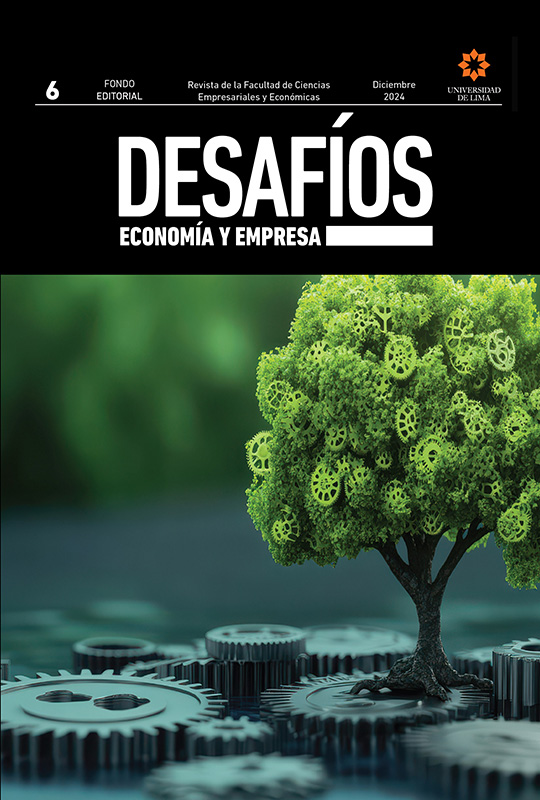Regional climate risk measurement: a contribution to the Peruvian economy
DOI:
https://doi.org/10.26439/ddee2025.n6.7169Keywords:
climate change, risk measurement, regional growthAbstract
Recent empirical literature recognizes that climate change is a serious threat to the growth prospects of our economy, which would seriously affect the welfare and employment of future generations. It is, therefore, important to know the extent of our exposition to the menaces of global warming. However, risk measurement indicators, such as those of Germanwatch or the University of Notre Dame, usually offer a score for a whole country, when in most cases, the damage caused by extreme weather events usually affects only smaller areas, such as a city or a region. In this sense, this paper introduces a climate risk measurement of regional scale applicable to Peru, which reveals that regions of the Andean Trapeze (Apurímac, Huancavelica, and Ayacucho) and part of the east (Loreto and Amazonas) are the most sensitive to the risk of climate change, while the coastal regions are in a relatively safer situation.
Downloads
References
Albala-Bertrand, J. M. (1993). Natural disaster situations and growth: A macroeconomic model for sudden disaster impacts. World Development, 21(9), 1417-1434. https://doi.org/10.1016/0305-750X(93)90122-P
Banco de Desarrollo de América Latina y el Caribe. (2023). Efectos del cambio climático en América Latina y el Caribe.
Banco Interamericano de Desarrollo. (2018). Informe anual 2017.
Banco Interamericano de Desarrollo & Comisión Económica para América Latina y El Caribe. (2014). La economía del cambio climático en el Perú. https://www.cepal.org/es/publicaciones/37419-la-economia-cambio-climatico-peru
Banco Mundial (2021, 16 de septiembre). World Bank Group to discontinue Doing Business report. https://www.worldbank.org/en/news/statement/2021/09/16/world-bank-group-to-discontinue-doing-business-report
Breckenfelder, J., Mackowiak, B., Marques, D., Olovsson, C., Popov, A., Porcellacchia, D., & Schepens, G. (2023). The climate and the economy. European Central Bank.
Chen, C., Noble, I., Hellmann, J., Coffee, J., Murillo, M., & Chawla, N. (2015). University of Notre Dame Global Adaptation Index Country Index Technical Report. University of Notre Dame. https://www.researchgate.net/publication/318431802_University_of_Notre_Dame_Global_Adaptation_Index_Country_Index_Technical_Report
Chirinos, R. (2021a). Un indicador de competitividad regional para el Perú. Revista Moneda, (185). https://www.bcrp.gob.pe/publicaciones/revista-moneda/revista-moneda-185.html
Chirinos, R. (2021b). Efectos económicos del cambio climático en el Perú. Banco Central de Reserva del Perú. https://www.bcrp.gob.pe/docs/Publicaciones/Documentos-de-Trabajo/2021/documento-de-trabajo-009-2021.pdf
Cruz, J. L., & Rossi-Hansberg, E. (2024). The economic geography of global warming. Review of Economic Studies, 91(2), 899-939. https://doi.org/10.1093/restud/rdad042
Eckstein, D., Künsel, V., & Shäfer, L. (2021). Global Climate Risk Index 2021. Germanwatch. https://www.germanwatch.org/en/19777
Feller, G. (2022). Medir el riesgo climático. Standard Social Innovation Review. https://ssires.tec.mx/es/noticia/medir-el-riesgo-climatico
Gobierno Regional Cusco. (2012). Estrategia regional frente al cambio climático. https://predes.org.pe/wp-content/uploads/2019/07/57.pdf
Gobierno Regional Piura. (2011). Estrategia regional de cambio climático. https://siar.regionpiura.gob.pe/documentos/normativa/779.pdf
Instituto Nacional de Estadística e Informática. (2024). Microdatos. https://proyectos.inei.gob.pe/microdatos/
Jovel, R. (1989). Natural disasters and their economic and social impact. Cepal Review, (38). https://repositorio.cepal.org/entities/publication/905beae8-f96d-4025-adc4-7415190bf6d6
Kahn, M., Mohaddes, K., N. C., R., Pesaran, M., Raissi, M., & Yang, J. (2019). Long-term macroeconomic effects of climate change: A cross-country analysis. International Monetary Fund. https://www.imf.org/en/Publications/WP/Issues/2019/10/11/Long-Term-Macroeconomic-Effects-of-Climate-Change-A-Cross-Country-Analysis-48691
Labra, O., & Maltais, D. (2013). Consecuencias de los desastres naturales en la vida de las personas. Revista Trabajo Social, (85). https://doi.org/10.7764/rts.85.53-67
Naoaj, S. (2023). From catastrophe to recovery: The impact of natural disasters on economic growth in developed and developing countries. European Journal of Development Studies, 3(2), 17-22. https://doi.org/10.24018/ejdevelop.2023.3.2.237
Nordhaus, W. (1992). The DICE model: Background and structure of a dynamic integrated climate-economy model of the economics of global warming. EliScholar.
Ordenanza regional 001-2022-GRA/CR [Gobierno Regional de Amazonas / Consejo Regional] declara de interés regional la implementación de la Estrategia Regional de Desarrollo Rural Bajo en Emisiones (ERDRBE) de la región Amazonas. 9 de febrero del 2022.
Ordenanza regional 261- GRJ/CR [Gobierno Regional de Junín / Consejo Regional] Ordenanza que crea el Consejo Regional de Cambio Climático de la Región Junín. 22 de mayo del 2017.
Programa de las Naciones Unidas para el Desarrollo. (2010). Gestión del Riesgo Climático.
Stern, N. (2007). The economics of climate change: The Stern review. Cambridge University Press.
Vargas, P. (2009). El cambio climático y sus efectos en el Perú. Banco Central de Reserva del Perú. https://www.bcrp.gob.pe/docs/Publicaciones/Documentos-de-Trabajo/2009/Documento-de-Trabajo-14-2009.pdf


